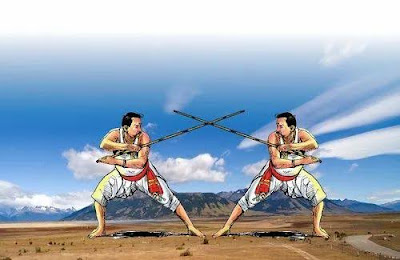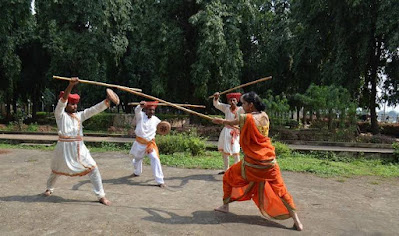-> Martial arts are a practice that had been used for various purposes such as
- Self Defence
- Military and law enforcement
- Competition
- Physical and Mental Development
- entertainment
-> Today, if anyone hears about Martial arts, The first name of country that enters his mind, would be 'China' because The Chinese people have put much effort to keep their culture of martial arts alive. They did it through various broadcast mediums like Films, advertisements etc and their schools also have karate sessions. The thing is Chinese people are very serious about the preservation of their culture.
-> The fact is, India also has martial arts. Not 1 or 2 or 3 but many. In this post, we will discuss them -
- Kalaripayatu
- Silambam
- Thang-ta and Sarit Sarak
- Cheibi Gad-ga
- Pari-khanda
- Thoda
- Gatka
- Mardani Khel
- Lathi
- Inbuan Wrestling
- Kuttu Varisai
- Musti Yuddha
1) Kalaripayatu
-> It is the oldest martial arts of India.
-> Originated in Kerala around the 4th century
-> according to some legends, It is introduced by Shri Parasurama (Anshavtar of supreme lord Vishnu)
-> It includes both armed and unarmed combat. It also includes physical exercise.
-> The most important aspect of Kalaripayatu is the style of fighting. The most important key is footwork It also includes kicks, strikes and weapon-based practice
-> Even can also practice this art.
-> It includes some techniques and aspects such as -
- The massage with Gingi oil
- Fighting with an S-shaped stick (Otta)
- Maipayattu (body exercises)
- Sword fight
- Bare handed fight
- Use of metal weapons and sticks of kolthari
2) Silambam
-> It is a modern and scientific martial art of Tamilnadu. It had been promoted since Chola times.
-> There are four kinds of staves used -
- The first one is the torch silambam. It has highlighted balls of cloth at one end
- the second one produces a sonorous swishing sound
- the third one is a non-elastic staff that gives clattering sounds
- the fourth one is short but powerful
-> The dress consists of Langots of different colours, a turban, sleeveless vests, canvas shoes and a chest guard.
-> Some different kinds of techniques used -
- Swift movement of the foot
- use of both hands to wield staff
- use of thrust, cut, chop and sweep to achieve mastery.
- development of force, momentum and precision at different levels of the body.
There are 3 ways to win -
- Dispose opponent
- the countings of no. of touches to the opponent
- judging the skills shown by each contestant
3) Thang-ta and Sarit sarak
-> Origin - Manipur by Meitei people. It was traced back to the 17th century when it was successfully used by the Manipuri kings to fight the British.
-> Thang-ta is an armed martial art while Sarit Sarak is an unarmed art.
-> Thang stands for sword and Ta stands for Spear
The two components thang-ta and Sarit sarak are together called Huyen Langlon.
Three different ways to practice this -
- ritualistic - includes tantric practices
- performance of sword and spear
- actual techniques of fighting
4) Cheibi Gad-ga
-> It also from Manipur, involves fighting using a sword and shield. It has now been modified to a stick encased in soft leather in place of a sword and a leather shield.
-> The contest takes place in a circle of 7 metres in diameter on a flat surface. There are two lines 2 metres apart within the circle.
the result is based on points.
5) Pari Khanda
-> It was created by Rajputs and it is from Bihar.
-> It involves fighting using Sword and Shield. still practised in many parts of Bihar.
-> Its steps are used in the Chhau dance.
-> Khanda = sword and pari = shield
6) Thoda
-> Originated in Himachal Pradesh.
-> It is a mixture of martial arts, sports and culture.
-> It takes place during Baisakhi. every year
-> The martial art relies on a player's skill of archery.
-> The two teams are called Pashis and Saathis, who are believed to be the descendants of Pandavas and Kauravans
7) Gatka
-> Originated - Punjab.
-> Weapon-based martial arts.
-> Some say that Gatka comes from the sanskrit word 'Gadha'
-> It features the skilful use of - Kirpan, Talwar and, Kataar
8) Mardani Khel
-> Origin - Maharashtra
-> Armed martial art, widely practised in Kolhapur.
-> Uses a sword and Vita (corded lance).
9) Lathi
-> It is just the use of Lathi in a different way to defend and attack
-> Indian police use lathi
-> World's oldest weapon
-> Majorly practised in Punjab and Bengal
10) Inbuan Wrestling
-> Origin - Mizoram. It is believed to have had its genesis in 1750 A.D. in Dungtlang village.
-> It has very strict rules that prohibit
- stepping out of the circle
- kicking and knee bending
-> The way to win this is by lifting the opponent off their feet.
-> This art form was regarded as a sport after the people of Mizoram migrated from Burma to the Lushai hills.
11) Kuttu Varisai
-> practised in Tamilnadu
-> Unarmed Dravidian martial art
-> It is used to advance athleticism and footwork through starching, yoga, gymnastics and breathing exercises.
-> It is considered as an unarmed component of silambam.
12) Musti Yuddha
-> Originated in one of the oldest cities of the country Varanasi.
-> Unarmed martial art (resembling boxing).
-> It uses techniques like kicks, punches, and knee and elbow strikes.
-> It was quite popular in the 1960s.
It incorporated the development of physical, mental and spiritual.
The fights in this art are divided into 4 categories which are named upon Hindu Gods -
- Jambuvanti - to force the opponent into submission through locking and holding.
- Hanumanti - technical superiority.
- Bhimaseni - focuses on sheer strength.
- Jarasandhi - concentrates on a limb and joint breaking.














0 Comments
Post a Comment